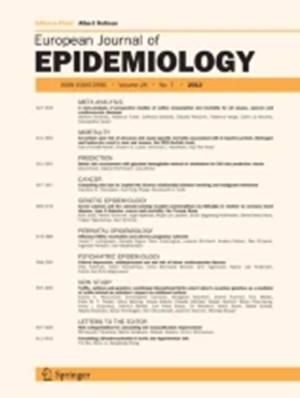Revisiting the hazards of hazard ratios through simulations and case studies.
IF 5.9
1区 医学
Q1 PUBLIC, ENVIRONMENTAL & OCCUPATIONAL HEALTH
引用次数: 0
Abstract
The hazard has been a central concept in the analysis and interpretation of time-to-event data for over 50 years. At any follow-up time, the hazard is the probability of the event happening in the next unit of time amongst those still at risk. Hazard ratios (HRs) between groups are frequently used to quantify the exposure/treatment's association with the failure time. In a highly cited paper, Hernán criticized HRs, asserting that their decreases over time may reflect simply a built-in selection bias, induced by an unmeasured susceptibility, and should not be interpreted as genuine changes in treatment effect. Hernán supports his arguments mainly by the results of a hormone therapy trial, where the HR for coronary heart events decreased largely during follow-up, with hazards crossing from harmful to protective treatment effect. However, he did not present simulations or algebraic derivations to demonstrate that these changes may reflect just an unmeasured susceptibility. We use simulations and real-world case studies to systematically explore this issue. The first simulation series reveals how the underestimation bias and changes over time in Cox proportional hazards model-based HRs depend on the joint impact of susceptibility on the hazard, its distribution, and the incidence of events; with important bias toward the null occurring only for a very strong susceptibility. Further simulations mimic the hormone therapy trial highlighted by Hernán, to demonstrate that the reported bias and crossing hazards are extremely unlikely to reflect just an unmeasured susceptibility, which suggests some biological reasons for decaying treatment HR, possibly including decreasing treatment adherence. Finally, we present real-world examples of interpretable and clinically plausible time-dependent HRs in cancer research. In conclusion, results of our simulations and real-world case studies suggest that concerns about HR limitations may be overstated, and we encourage researchers to model time-dependent HRs and consider potential biological and clinical causes thereof.通过模拟和案例研究重新审视风险比的危害。
50多年来,灾害一直是分析和解释事件发生时间数据的中心概念。在任何后续时间,危害是事件在下一单位时间内发生在仍处于危险中的人群中的概率。两组间的危险比(hr)常用于量化暴露/治疗与失效时间的关系。在一篇被高度引用的论文中,Hernán批评了hr,声称它们随着时间的推移而减少可能仅仅反映了一种内在的选择偏差,这是由一种未测量的易感性引起的,不应该被解释为治疗效果的真正变化。Hernán主要通过一项激素治疗试验的结果来支持他的观点,在随访期间,冠心病事件的HR大幅下降,危险从有害到保护治疗效果。然而,他没有提出模拟或代数推导来证明这些变化可能只是反映了一种无法测量的敏感性。我们使用模拟和现实世界的案例研究来系统地探讨这个问题。第一个模拟系列揭示了基于Cox比例风险模型的hr的低估偏差和随时间变化如何取决于易感性对风险、其分布和事件发生率的共同影响;只有在非常强的磁化率下,才会出现对零值的重要偏差。进一步的模拟模拟了Hernán强调的激素治疗试验,以证明报告的偏倚和交叉危险极不可能仅仅反映未测量的易感性,这表明治疗HR衰减的一些生物学原因,可能包括治疗依从性降低。最后,我们提出了癌症研究中可解释和临床可信的时间依赖性hr的真实例子。总之,我们的模拟结果和现实案例研究表明,对人力资源限制的担忧可能被夸大了,我们鼓励研究人员建立时间依赖性人力资源模型,并考虑潜在的生物学和临床原因。
本文章由计算机程序翻译,如有差异,请以英文原文为准。
求助全文
约1分钟内获得全文
求助全文
来源期刊

European Journal of Epidemiology
医学-公共卫生、环境卫生与职业卫生
CiteScore
21.40
自引率
1.50%
发文量
109
审稿时长
6-12 weeks
期刊介绍:
The European Journal of Epidemiology, established in 1985, is a peer-reviewed publication that provides a platform for discussions on epidemiology in its broadest sense. It covers various aspects of epidemiologic research and statistical methods. The journal facilitates communication between researchers, educators, and practitioners in epidemiology, including those in clinical and community medicine. Contributions from diverse fields such as public health, preventive medicine, clinical medicine, health economics, and computational biology and data science, in relation to health and disease, are encouraged. While accepting submissions from all over the world, the journal particularly emphasizes European topics relevant to epidemiology. The published articles consist of empirical research findings, developments in methodology, and opinion pieces.
 求助内容:
求助内容: 应助结果提醒方式:
应助结果提醒方式:


